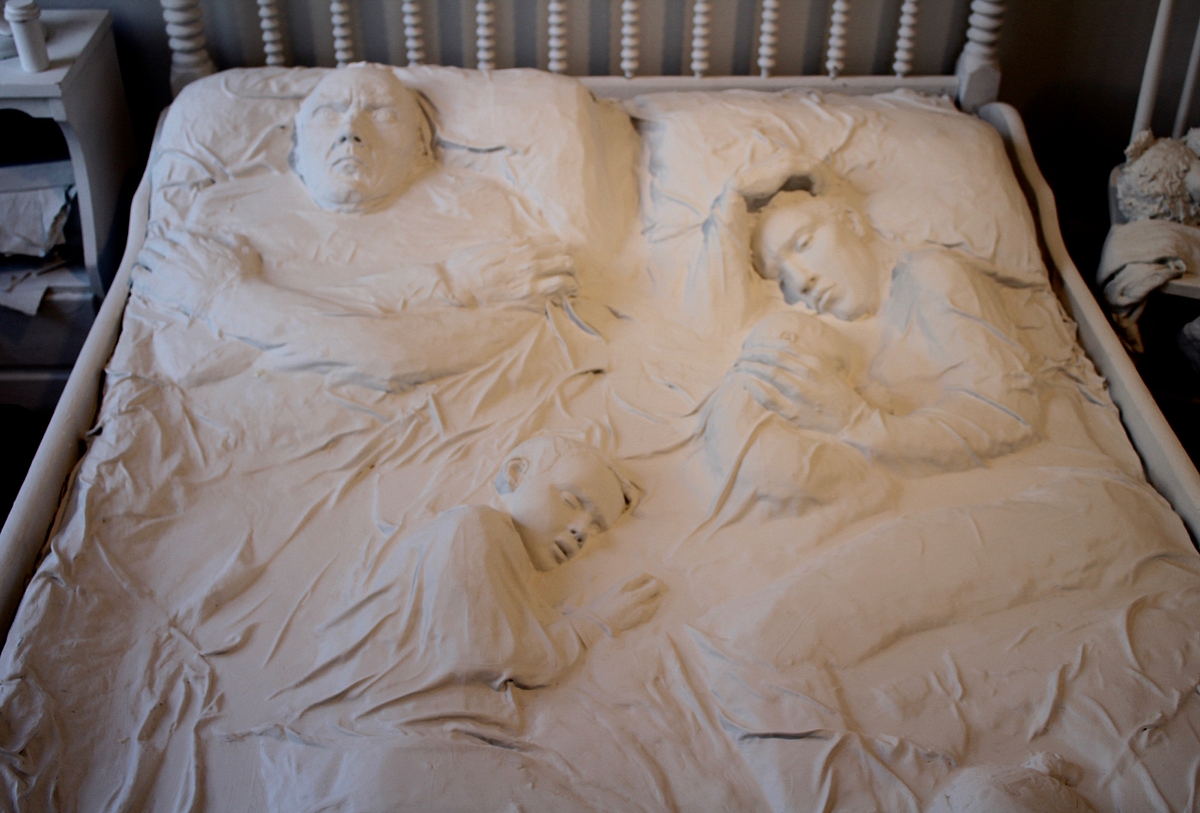
Susan Clinard
In Fear We Trust: Pandemic Family Portrait.
Susan Clinard’s In Fear We Trust: Pandemic Family Portrait is a snapshot of a harrowing moment. The figures in the bed show an astonishing range of emotion, from anger to worry to terror. But the piece itself isn’t an incitement to anger, but compassion. The family may be up late at night, their emotions eating away at them as they surely did for many in the depths of 2020. But Clinard makes sure we see that together they’re drawing strength from one another too. When times are hard, they gather together.
Clinard’s piece is part of “Akwaaba,” which, along with the show “Primal Affinities,” runs now through Jan. 5 at the Ely Center of Contemporary Art.
“In this moment there is an opportunity to reconnect,” writes Shaunda Holloway, who curated “Akwaaba.” “These past few years have separated us on many levels through social distancing, especially when it comes to art. Though there have been countless digital exhibitions — this one physically opens its doors to your eyes and your soul. Home is where art is seen everyday — in furniture, upholstery, paintings, clothing and more. Home is intimate. Join us as we share with the viewer our appreciation for connectivity beyond virtual hugs.”
Holloway’s tone is appropriate to the title; the word akwaaba means “welcome” in Twi, the language of the Ashanti, in Ghana. It’s also appropriate to describing “Primal Affinities,” which isn’t as precisely concerned with creating intimate spaces as “Akwaaba” is, but is made up of art that reaches out to viewers, inviting them in to explore. In the gallery, it is at times hard to say which artist belongs to which show, which is a strength; together, the two shows make the Ely Center feel as friendly and empathic as ever.

David Holzman
Structure 11 and Structure 15.
On the “Akwaaba” side of the show, Clymenza Hawkins’s piece Teepee Chrysalis brims with strength and possibility. David Holzman’s structures evoke old-school fairy tales — the kind that don’t always end well — with their drawings of twisted figures, animals, and the occasional monster. But they’re a reminder that those stories weren’t intended simply to frighten; they helped mentally prepare children for difficulties in their lives. The stories could make them stronger.

Shaunda Holloway
Shaunda Holloway’s series of pieces, meanwhile, turn the most normal and domestic of spaces — the living room — into places brimming with self-expression and connection to ancestry. As Holloway’s curatorial note suggests, In “Akwaaba” as a whole, it is as if the artists have opened their homes to us, showing us the power they draw from family, friends, and personal history, even if (perhaps because?) those relationships and that ancestry are complex, and the road not always easy. Maybe it’s cliché to argue that we’re stronger together, but that doesn’t make it less true, or less worthy as a subject for artistic exploration, to show the many ways that it might be.

Linda King Ferguson
Equivalence 88 and Equivalence 87.
In that context, “Akwaaba” finds real kinship with the parallel show at the Ely Center, “Primal Affinities,” which features the works of artists Steven DiGiovanni, Linda King Ferguson, Donna Forma, Becca Lowry, Greg Slick, and Kim Weston. Slick’s and Ferguson’s paintings partake of a playful, comforting abstraction that delights and intrigues, while Kim Weston’s work, as always, explodes with energy, movement, and the pride and strength that come with connection to heritage.

Steven DiGiovanni
Untitled (chasm).
Steven DiGiovanni’s large, fanciful canvases of fantastical places in some cases almost literally crackle with energy. As foreboding as some of his visions may be, they also bristle with the possibility of adventure. They’re not places to avoid; they’re places to infiltrate.

Layers.
Donna Forma’s sculptures have something in common with DiGiovanni’s paintings in the way she uses materials to create objects that seem, on some level, like they shouldn’t exist. A sculpture made of fabric seems to float off the wall. Another one made partly from tree branches climbs toward the ceiling. Layers, meanwhile, sits in the middle of one of the gallery spaces like an improbable egg. What kind of creature might hatch from it?

Becca Lowry
The Santa Anas.
Finally, Becca Lowry’s pieces often trace the patterns of biological forms (this reporter sees sea fauna — fish, rays, and the like) but then use them to explore textures that are also full of color. They share some of the decisive power of Holloway’s pieces, and the playfulness of many of the artists in both shows. Perhaps most like Forma’s and DiGiovanni’s pieces, they encourage the viewer to explore, to travel in their mind to a place that might be the natural habitat for Lowry’s creations. The sculptures also remind us that similar things exist in the real world, outside, just over the horizon, waiting for us to see.
“Akwaaba” and “Primal Affinities” run at the Ely Center of Contemporary Art, 51 Trumbull St., through Jan. 5. Visit ECOCA’s website for hours and more information.